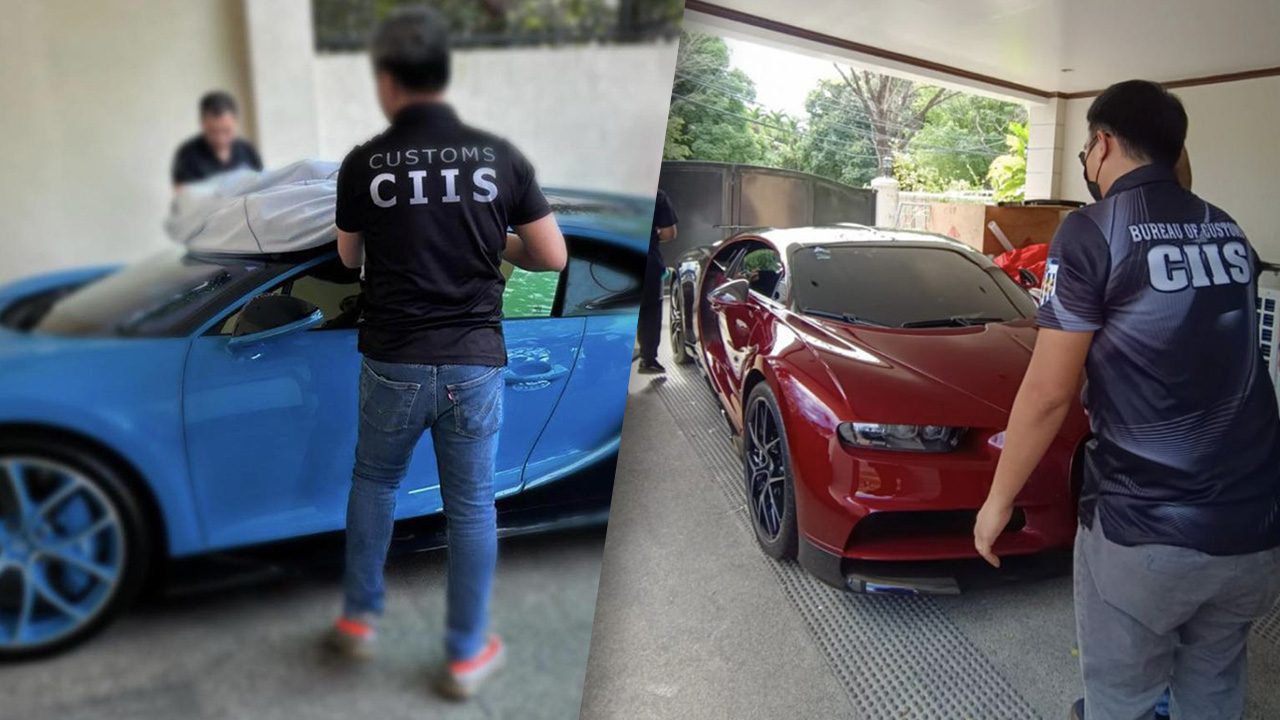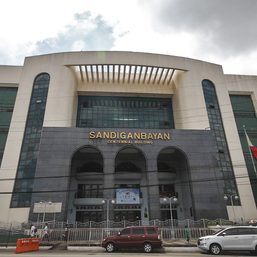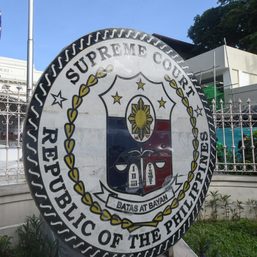SUMMARY
This is AI generated summarization, which may have errors. For context, always refer to the full article.

After a three-week search, the Bureau of Customs (BOC) finally recovered the two luxury sports cars that were smuggled into the Philippines.
These were no ordinary cars. Both were Bugatti Chirons – cars so rare that only 500 units were ever produced from 2016 to 2022 in a Bugatti factory in France. Each is priced at around $3 million or P165 million, an amount that would take the minimum wage earner more than 750 years of daily work to achieve.
The BOC didn’t so much find the cars as have their owners surrender them – perhaps out of fear after Customs called on the public to help spot the sports cars on the road.
But behind the triumph of Customs in its search is a host of questions: How did two of these vehicles find their way to the Philippines? How did the importers and owners cheat the government out of hundreds of millions in duties and taxes? And how did these illegally imported cars get their paperwork done by the Land Transportation Office (LTO) without anyone noticing?
It began in late 2022 when the two luxury cars likely entered the country, as evidenced by a bill of lading dated December 24, 2022 and a certificate of payment issued by Customs on December 27, 2022.
Things get fishy right from the start, as the certificate of payment shows only P24.7 million – or P24,787,838.82 to be exact – was paid in customs duty. Meanwhile, an estimate by Inquirer.net suggests that the customs duty should have been about P49.5 million, with the total duties and taxes supposed to reach more than P160.5 million.
But despite this questionable customs payment, the vehicles were somehow registered under the LTO. The blue Bugatti – with a plate number of NIM5448 – was registered under Thu Trang Nguyen, while the red Bugatti – with plate number NIM5450 – was registered under Mengjun Zhu.
The vehicles were registered with the LTO on the same day, May 30, 2023. This happened to be a turbulent time for the agency. A week before, on May 22, Jose Art Tugade resigned from his post as LTO head over the shortage in plastic cards for drivers’ licenses. Hector Villacorta, a communications assistant secretary for the Department of Transportation (DOTr), only stepped in as LTO’s officer-in-charge on June 1.
That means from May 22 to May 31, the LTO was likely in a messy transition period, and the smuggled vehicles just so happened to have been registered during this window. Coincidence?

Gaps in the system
So how did these vehicles get through the LTO’s system? It turns out that there are glaring gaps in the system used for vehicle registration, sources close to the LTO told Rappler.
The LTO is currently in the process of transferring all its operations from its old IT system provider, Stradcom, to the government-owned Land Transportation Management System (LTMS) portal. However, because not all processes have been fully swapped, LTO personnel may still sometimes register vehicles in the old Stradcom IT system rather than the LTMS.
This is, in fact, what happened in the case of the two Bugatti Chirons. The LTMS’ service providers – a joint venture headed by German company Dermalog – said that both luxury vehicles were not registered in the LTMS, asserting they “would not have been able to be registered in LTMS as the robust security features of LTMS would have prevented such registration to occur.”
Sources close to the LTO also separately confirmed to Rappler that the vehicles were not registered in the LTMS. Instead, it seems the vehicles were registered through the LTO’s old IT system provided by Stradcom.
The LTO wrote to Stradcom on February 21, 2024 to ask for an audit trail “to determine who are the personnel involved in the processing of the registration of the said vehicles,” based on an initial report seen by Rappler regarding the LTO-NCR’s investigation into the matter.
The problem is that vehicle registrations processed through the Stradcom IT system have a weaker audit trail, a source close to the LTO told Rappler. This is because under the old system, paper documents are not scanned, making it more difficult for other officers to conduct audits or due diligence.
Another LTO source told Rappler that it might be possible for an improper certificate of payment to get through the system because it is beyond the scope of the LTO’s work to double-check if customs duties were correctly paid. Once the Bureau of Customs electronically reports the certificate of payment, the LTO issues a certificate of stock reported (CSR), a document that acts like a car’s “birth certificate” and serves as evidence that it was manufactured or imported in the Philippines.
The LTO, in its initial report, also seemed to deflect responsibility away from the agency when it came to the issue of the improper certificate of payment and the resulting CSR.
“Liaison officers of the accredited manufacturers, assemblers, and importers are responsible for inputting data into the LTO system based on the Certificate of Payment issued by the BOC. They independently handle all stages, including evaluation, approval, and the printing of the CSR. The LTO’s role is limited to the processing of payments,” the LTO said in its report.
“The validity and processing of the CSR are dependent upon the issuance and successful transmission of the Certificate of Payment issued by the BOC. Although LTO employees play a vital role in vehicle registration, their primary function is to facilitate the application process and ensure adherence to established regulations. Their duties are purely ministerial in nature. As long as the requirements are met, motor vehicle registration would proceed,” the agency added.
But even then, a misdeclared CSR was far from being the only issue here.

P1 million Bugatti?
Aside from a CSR, an original sales invoice is one of the documents needed to register a vehicle with the LTO. But as with the undervalued customs document, there were also anomalies in the sales invoice for the Bugatti Chirons.
The LTO initial report seen by Rappler questioned why each Bugattin Chiron was listed as worth only P1 million – a fraction of the vehicle’s usual price – in two sales invoices dated May 30, 2023. The two sales invoices also did not indicate the breakdown for 12% value added tax (VAT), VATable sale, VAT-exempt sale, zero-rated sale, and total sale.
Remember, the Bureau of Customs estimated the value of the luxury car at around P165 million each. Similar to what happened with the customs payment, it’s possible that the vehicles were undervalued to lessen or avoid taxes paid.
The question here then becomes how the LTO and its system failed to flag the Bugatti Chirons with conflicting sales prices of only P1 million and customs duties of P24.7 million – both of which were obviously incorrect in the first place.
Rappler reached out to the LTO’s intelligence and investigation head for clarification but received no response.
Importer without a warehouse
The irregular sales invoices were issued by Frebel Import and Export Corporation, the same company that imported the vehicles into the Philippines based on the bill of lading.
Based on Frebel’s latest certificate of accreditation obtained by Rappler, the company’s address is at Room 317 Femil Building, A. Soriano Avenue, Barangay 656, Intramuros, Manila, putting it under the jurisdiction of LTO NCR West.
However, Frebel’s initial accreditation as an importer was processed by the LTO NCR East regional office when it should instead have been processed by the LTO NCR West regional office.
Frebel was first certified by Benjamin Santiago, then-regional director for LTO NCR-East on August 11, 2022. Frebel then received a certificate of accreditation as an importer and dealer from Teofilo Guadiz III, who was then the LTO assistant secretary. Guadiz currently sits as the head of the Land Transportation Franchising and Regulatory Board, where he has weathered accusations of corruption. (READ: From LTFRB to Malacañang: Insider says Teofilo Guadiz at center of bribes)
The accreditation history of Frebel as an importer and dealer was irregular, as flagged by the LTO investigation in its report. After the “discovery of the questionable processing of the accreditation of Frebel,” members of the Monitoring Committee for Accreditation of Regional Assessment and Compliance paid a visit to Frebel morning of February 19.
“The inspection report identified the absence of both a showroom and a warehouse at the accredited entity’s registered address. Additionally, the report noted the lack of any visible import or dealer signage,” the LTO said in the initial report seen by Rappler.
In light of this, the LTO’s investigation committee recommended issuing a show cause order against Frebel that would compel them to address potential violations. The committee, in its report, also said that “considering the severity of the alleged violations, the issuance of a preventive suspension is deemed necessary.”
The LTO will also investigate Frebel’s liaison officer and Customs broker, as well as the company’s Securities and Exchange Commission documents.
Whose fault is it?
Again, the LTO seemed to downplay its responsibility to verify the legitimacy of its importers and dealers, pointing instead to a supposed “loophole” in the Manufacturers, Assemblers, Importers, Rebuilders, Dealers and Other Entities (MAIRDOE) portal system that handles the accreditation of importers and dealers.
“Online submissions for accreditation renewal of MAIRDs offered convenience and efficiency, but also raised concerns about bypassing verification processes. This approach offered a loophole that was manipulated to get accredited without meeting all the crucial requirements. In-depth verification procedures are crucial to ensure only qualified importers renew their accreditation,” the LTO said in its initial report.
But the question here is: why did the LTO not do its own due diligence before approving or renewing Frebel’s accreditation as an importer and dealer? A simple site visit would have already revealed Frebel’s lack of a warehouse and showroom. Rappler is trying to get the side of Frebel and will update this story once we are able to.
The DOTr has already requested the National Bureau of Investigation and Jose Lim IV, DOTr’s Assistant Secretary for Road Transport Non-Infrastructure and Special Action and Intelligence Committee for Transportation, to look into the smuggling of the luxury vehicles, a source close to the LTO told Rappler. A copy of the LTO’s report was also submitted to Transportation Secretary Jaime Bautista on February 23, 2024.
Investigators from the NBI and Office of the Solicitor General visited the LTO Central Office on Thursday, February 29, an LTO source told Rappler. Meanwhile, the DOTr has spoken up on the issue, declaring that “documentary and procedural irregularities appear to surround the eventual registration of these luxury vehicles.” – Rappler.com
Add a comment
How does this make you feel?






![[Under 3 Minutes] When will we see modern jeepneys on the road?](https://www.rappler.com/tachyon/2024/04/francisco-motors-modern-jeepney-prototype-1.jpg?resize=257%2C257&crop=590px%2C0px%2C1012px%2C1012px)


There are no comments yet. Add your comment to start the conversation.